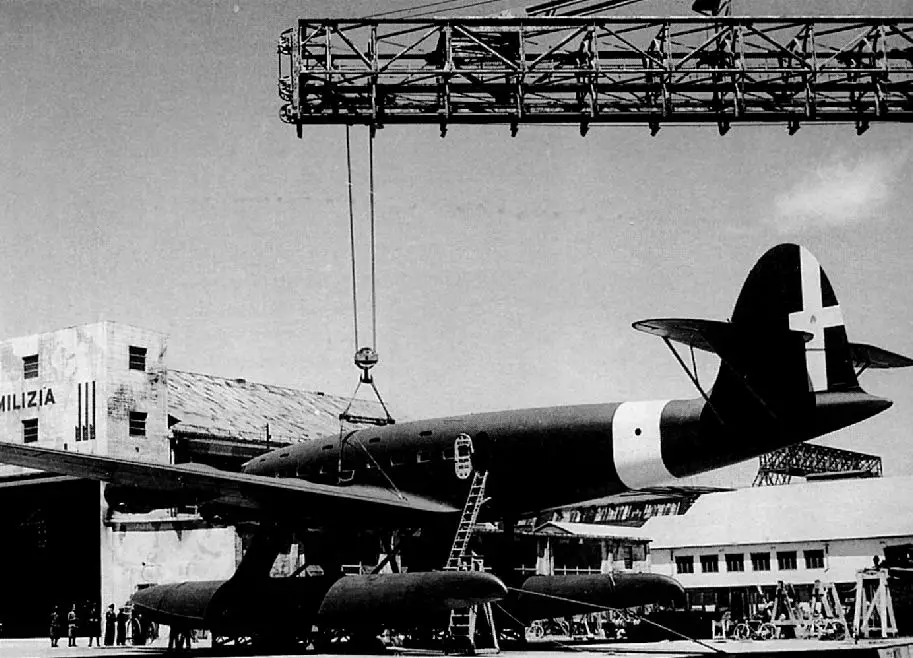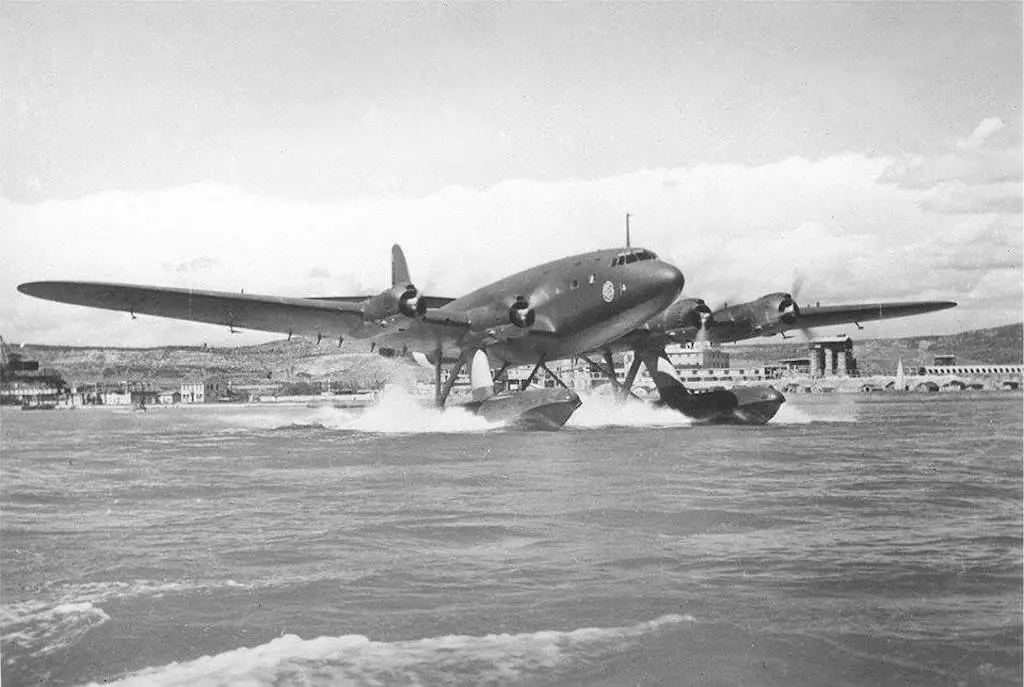The CANT Z.511 was a large, four-engine seaplane designed for transatlantic flights between Europe and Central and South America. When Italy entered World War Two, the Regia Aeronautica devised a number of possible uses for the aircraft. However, only one prototype became operational.

The CANT Z.511 in 1939.
Origin and Development
In 1937, the Ala Littoria company announced to its shareholders the willingness to launch an airline between Italy and South America. At the time Ala Littoria had only triple-engine aircraft of wooden production. However, the establishment of the new airline required the construction of a new metallic airplane with four engines. The report prepared by the company on this matter specified that a four-engine layout would free the fuselage from vibrations caused by the central engine. The central engine also had the drawback of reduced visibility from the cockpit. The report, not indicating the preference for a seaplane or a land-based plane, disclosed important achievements in the field of seaplanes by the British company Short, American Boeing, French Latécoère, German Dornier and Blohm-Voss.

In late 1937, Filippo Zappata from the Cantieri Riuniti dell’Adriatico (CRDA) Technical Office, completed the 1:50 scale rough drawings of the seaplane, envisioned by the mentioned report from Ala Littoria.
The result was the magnificent Cant. Z.511, the largest floatplane ever built. The forward fuselage contained the cockpit, with seats for the Pilot, Co-Pilot, Mechanic, and Radio Operator, The central main section has two levels: the lower one (about 1 meter high) contained a 15-meter-long luggage compartment. The upper level had 48 armchairs divided into four compartments of 12 seats each. The slender floats were 17.50 meters long and high enough to allow a standing person to fit in.
History of the Prototypes
In 1938 the Ala Littoria announced the production of one CANT Z.511 for completion by the end of 1939. The second prototype was commissioned in early 1939. The plane design called for the mounting of Alfa Romeo 135 engines. But the production of these engines was too few in numbers. This huge delay in engine design and production led the engineers to find new alternatives.
CANT Z.506 Airone Overview and Specifications
The first option included buying six American Wright Cyclone R-2600 A (2 B) engines, believed to have adequate power to mounted on the giant CANT Z.511. The deteriorating international situation and further administrative problems halted this project. Thus CRDA decided to equip the airplane with the Piaggio P.XII RC.35 engines. These engines were capable of 1,500 hp at take-off and 1,350 hp. at 3,500 meters above sea level.
This new engine was far from perfect and often incurred several inconveniences. However, it was the only engine able to power an aircraft of such a large size. The CANT Z.511 had an empty weight of 20,600 kg. and the total weight of over 34,000 kg.
World War Two
Italy suspended the idea of any flight connections to Latin American once they entered the Second World War. The Regia Aeronautica began considering the adaptation of the CANT Z.511 as a long-range maritime patrol and a naval bomber equipped with a 533 mm torpedo – those mounted on destroyers. This arrangement, which remained on paper, would allow the CANT Z.511 to attack enemy formations without entering within range of AA fire.
Among other the projects taken into consideration:
- Plans to free fifty Italian soldiers and pilots imprisoned in Jeddah by Arab-English forces.
- Bomb Russian ports on the Black Sea (Bathumi and Poti), on the Caspian Sea (Baku).
- Bomb British bases on the Persian Gulf (oil ports in Bahrain).
- A propaganda based mission involving taking off from Bordeaux and twice being resupplied by German U-Boats. Then dropping one ton of tri-colored leaflets over New York City.
- Deploy human torpedos and attack the New York harbor.
Flight tests were conducted between October 1940 and May 1942. The prototype experienced a long series of inconveniences and problems needing constant tackling from maintenance personnel.
After the Armistice
During the armistice of 8 September 1943, the operational Cant.Z.511 prototype was based at the seaplane base of Vigna di Valle on the Bracciano lake. The ground crew sabotaged the slender floats to prevent the aircraft from falling into German hands. The airplane subsequently sank in the lake. It is not clear whether the CANT Z.511 was later recovered and scraped or if it still lays on the lakebed in front of the seaplane base (which today hosts the Air Force Museum).
The second prototype never completed assembly and thus its pieces remained in the CRDA factory in Monfalcone. When the German seized the based, they scrapped the pieces for re-use.
Specifications
| Model | CANT Z.511 |
|---|---|
| Crew | 4 Pilot, Co-Pilot, Radio Operator, and Mechanic |
| Powerplant | (4) Piaggio P. XII RC35 radial piston engine 1,500 hp |
| Maximum Speed | 263 mph (424 km/h) |
| Max Ceiling | 24,600 ft (7,500 m) |
| Range | 2,703 miles (4,350 km) |
| Length | 93 ft 6 in (28.5 m) |
| Height | 36 ft 8 in (11 m) |
| Weight | Empty: 45,619 lb (20,692 kg) Max: 75,398 lb (34,200 kg) |
| Wing Area | 2,100 Sq ft (195 m2) |
| Wingspan | 130 ft 9 in (39.86 m) |
| Armament | None |
Sources
Civoli M., Aereoplani: Regia Aeronautica-Aeronautica Militare 1923-2003 (2002).
www.aerimilitari.org